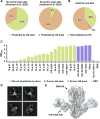This is a preprint.
An explainable language model for antibody specificity prediction using curated influenza hemagglutinin antibodies
- PMID: 37745338
- PMCID: PMC10515799
- DOI: 10.1101/2023.09.11.557288
An explainable language model for antibody specificity prediction using curated influenza hemagglutinin antibodies
Update in
-
An explainable language model for antibody specificity prediction using curated influenza hemagglutinin antibodies.Immunity. 2024 Oct 8;57(10):2453-2465.e7. doi: 10.1016/j.immuni.2024.07.022. Epub 2024 Aug 19. Immunity. 2024. PMID: 39163866
Abstract
Despite decades of antibody research, it remains challenging to predict the specificity of an antibody solely based on its sequence. Two major obstacles are the lack of appropriate models and inaccessibility of datasets for model training. In this study, we curated a dataset of >5,000 influenza hemagglutinin (HA) antibodies by mining research publications and patents, which revealed many distinct sequence features between antibodies to HA head and stem domains. We then leveraged this dataset to develop a lightweight memory B cell language model (mBLM) for sequence-based antibody specificity prediction. Model explainability analysis showed that mBLM captured key sequence motifs of HA stem antibodies. Additionally, by applying mBLM to HA antibodies with unknown epitopes, we discovered and experimentally validated many HA stem antibodies. Overall, this study not only advances our molecular understanding of antibody response to influenza virus, but also provides an invaluable resource for applying deep learning to antibody research.
Conflict of interest statement
DECLARATION OF INTERESTS N.C.W. consults for HeliXon. The authors declare no other competing interests.
Figures





Similar articles
-
An explainable language model for antibody specificity prediction using curated influenza hemagglutinin antibodies.Immunity. 2024 Oct 8;57(10):2453-2465.e7. doi: 10.1016/j.immuni.2024.07.022. Epub 2024 Aug 19. Immunity. 2024. PMID: 39163866
-
Mutations in Influenza A Virus Neuraminidase and Hemagglutinin Confer Resistance against a Broadly Neutralizing Hemagglutinin Stem Antibody.J Virol. 2019 Jan 4;93(2):e01639-18. doi: 10.1128/JVI.01639-18. Print 2019 Jan 15. J Virol. 2019. PMID: 30381484 Free PMC article.
-
Stringent and complex sequence constraints of an IGHV1-69 broadly neutralizing antibody to influenza HA stem.Cell Rep. 2023 Nov 28;42(11):113410. doi: 10.1016/j.celrep.2023.113410. Epub 2023 Nov 16. Cell Rep. 2023. PMID: 37976161 Free PMC article.
-
Role of Memory B Cells in Hemagglutinin-Specific Antibody Production Following Human Influenza A Virus Infection.Pathogens. 2019 Sep 28;8(4):167. doi: 10.3390/pathogens8040167. Pathogens. 2019. PMID: 31569328 Free PMC article. Review.
-
Influenza vaccination strategies targeting the hemagglutinin stem region.Immunol Rev. 2020 Jul;296(1):132-141. doi: 10.1111/imr.12887. Epub 2020 Jun 16. Immunol Rev. 2020. PMID: 32542739 Free PMC article. Review.
Cited by
-
Supervised fine-tuning of pre-trained antibody language models improves antigen specificity prediction.PLoS Comput Biol. 2025 Mar 31;21(3):e1012153. doi: 10.1371/journal.pcbi.1012153. eCollection 2025 Mar. PLoS Comput Biol. 2025. PMID: 40163503 Free PMC article.
References
Publication types
Grants and funding
LinkOut - more resources
Full Text Sources
